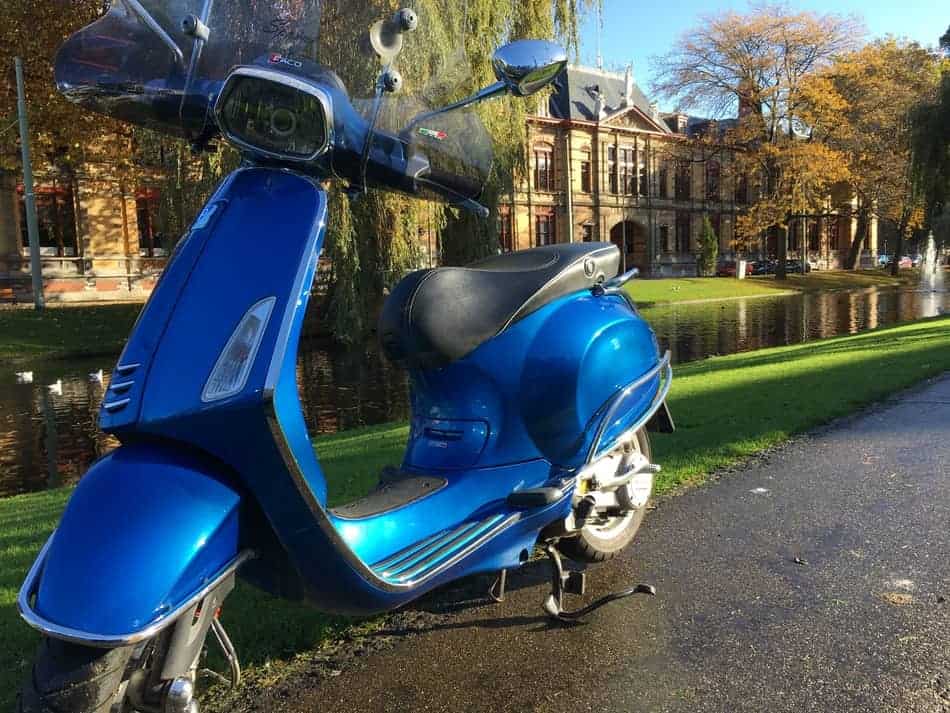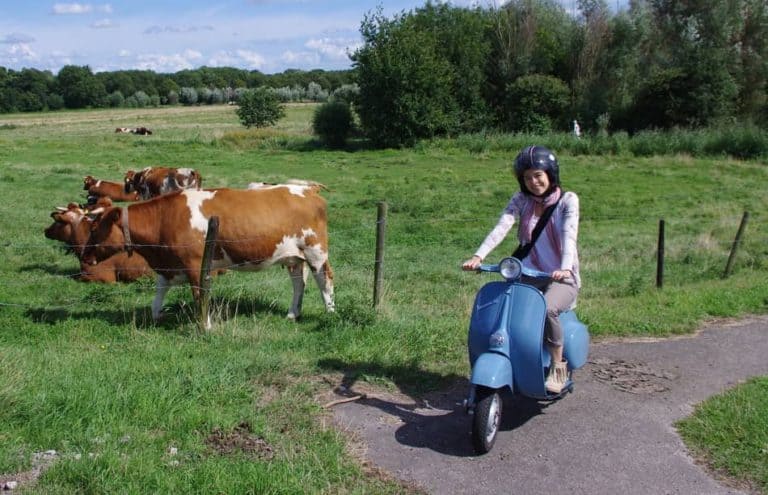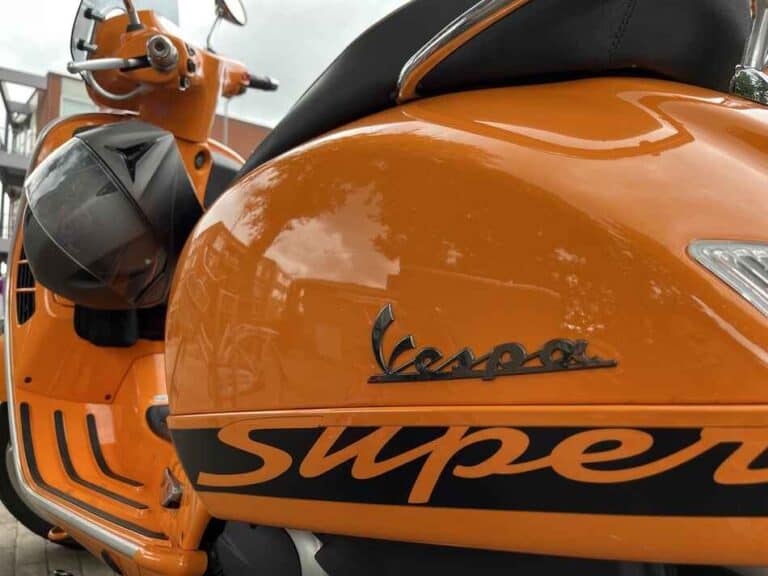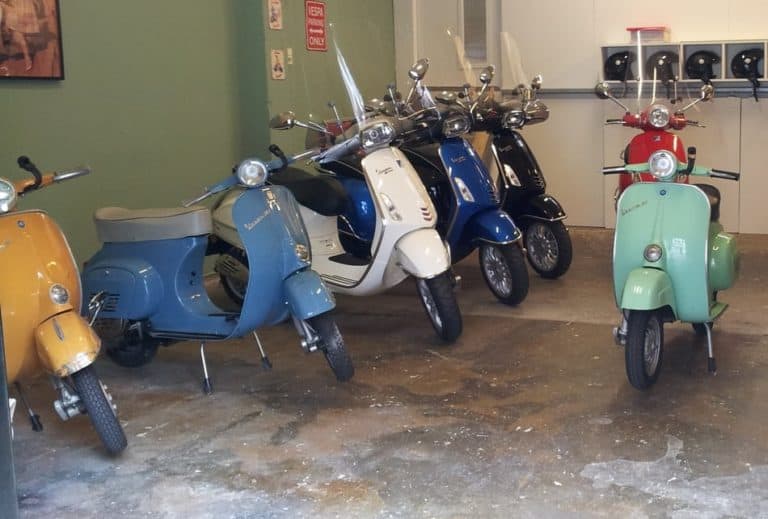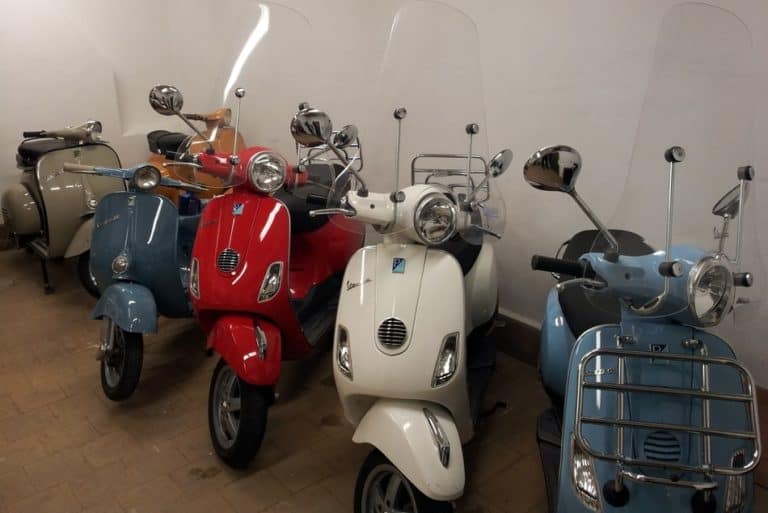Vespa 2-stroke Or 4-stroke, The Good And Bad
If you are looking for a Vespa to buy you will soon find three options when it comes to engine type: the electric, the 2- and 4-stroke gas engines. While the electric engine is upcoming, the gas engines are still the most common in the Vespa. If you are new to the motor scooter world, then it is useful to get to know the differences between these engines.
Not only is driving a 2-stroke Vespa a different experience than a 4 stroke, but the fuel consumption, oil use, and power are different too. These factors might make you reconsider purchasing a specific Vespa model.
Today Piaggio only makes Vespas with 4-stroke engines and electric engines. The 2-stroke can only be found on the second-hand market now. Some of these 2-stroke Vespas are older than 60 years old, which says enough about these types of engines.
That said, there is a reason why Vespa doesn’t have any new models with 2-stroke engines anymore, despite it being more favorable than the 4 stroke engine. Let’s have a look at how these engines precisely work and then check what the good and the bad are of both engines so you can decide for yourself which Vespa engine fits you best.
2- and 4 stroke Vespa engines work differently
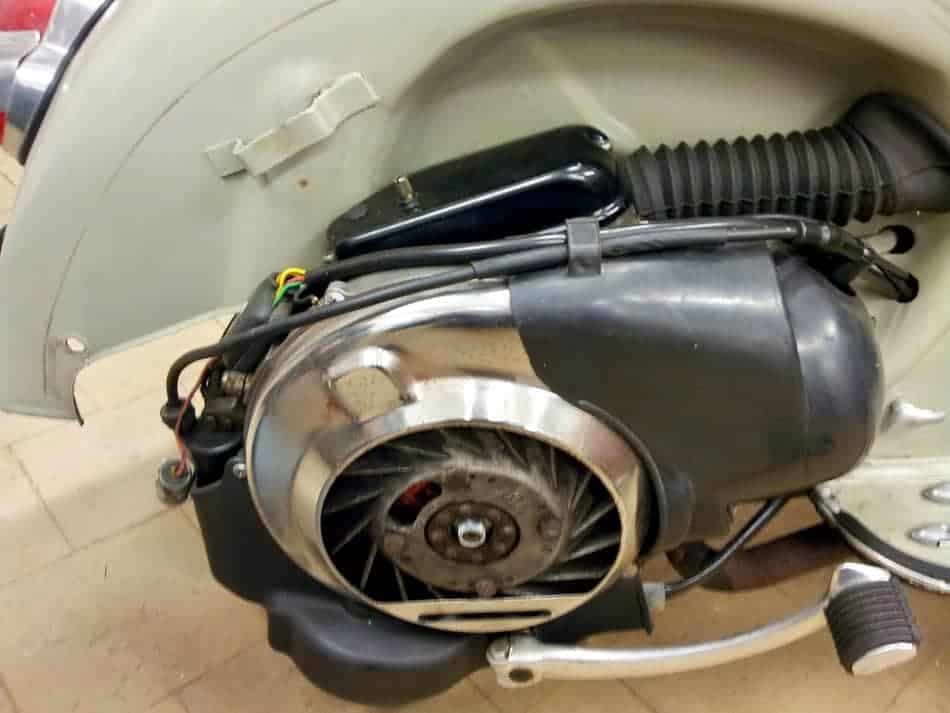
The 2-stroke engine has an old and simple technique that until today is still appreciated. The 4 stroke engines have been implemented by Piaggio since 1997 and ever since its technology is being improved to decrease fuel consumption and emission.
Below you can find a quick explanation of how both engines work. You don’t need to know exactly how it works to drive a Vespa, but it is pretty interesting to understand the differences between the two.
The 4 stroke engine
The 4 stroke engine has 4 strokes to complete a full cycle and is an internal combustion engine. The 4 strokes are:
- Intake stroke – the piston moves fully downward creating a reduction in the cylinder. This draws the fuel-air mixture through the intake port into the cylinder.
- Compression stroke – the piston moves up and the fuel-air mixture is compressed. The spark plug then ignites the fuel and air which results in combustion.
- Power Stroke – the combustion heat increases the pressure and pushes the piston back down which creates ‘the power stroke’
- Exhaust stroke – the piston then moves up again pushing the remaining exhaust out through the open exhaust valve. The pistol moves downwards again only to repeat the cycle.
For a visual and better understanding of how a 4-stroke engine works, have a look at this video. The video is about a 4-stroke car engine but the idea is the same for a Vespa. Scroll to 0.25 seconds to see the clear explanation:
The 2 stroke engine
The 2 stroke engine only needs 2 piston movements to complete a full cycle. The intake of gas and the exhaust occurs at the same time and is considered a more ‘simple’ technique.
- Compression – the air-fuel-oil mixture enters when the intake port opens. At the same time, the piston moves upwards and compresses the air-fuel-oil mixture in the cylinder which ignites the spark plug.
- Power stroke – the pressure of the heated gas moves the piston downwards, resulting in the ‘power stroke’. The burnt gases are then sucked through the exhaust port. The piston then continues moving fully downwards for the next intake of the air-fuel-oil mixture. This cycle repeats 1000 times per minute.
This video is really great to fully understand how a 2-stroke engine works.
A 4-stroke engines consumes less fuel then a 2-stroke
With the 4-strokes being the ‘modern and sophisticated’ engine compared to the older 2-stroke engine, we could automatically assume that the 4-stroke is more fuel-efficient.
There are various opinions about the fuel consumption of a 2-stroke engine. Some say that it uses twice as much fuel as a 4-stroke because it has more RPM (rotations per minute). However, there are others who say that the difference in fuel consumption isn’t that bad. The 4-stroke uses 25% less fuel than a 2-stroke according to motorscooterguide.com. There will always be a bit more output of gas in a 2-stroke engine during the intake stroke.
With the Vespa, we can easily make conclusions on which engine has a higher fuel consumption. The Vespa LX is one of the few modern Vespa scooters that come in a 2- and 4-stroke engine. We can also add a classic Vespa Primavera and a modern Vespa Primavera for a more thorough comparison.

| Model | Fuel consumption |
| Vespa 50 LX 2T (2012) | 3 L/100 km; 33 km/l; 79 mpg |
| Vespa 50 LX 4T | 2.7 L/100 km; 37 km/l; 87mpg |
| Vespa 125 Primavera 2T (1967) | 2.0L/100 km; 117mpg |
| Vespa 125 Primavera 4T (2015) | 3.1 L/100 km; 31km/l; 75 mpg |
When it comes to fuel consumption it is pretty surprising how little the differences are between the 2- and a 4-stroke engine of a modern Vespa. It is far less than the 25 and 50% as many claimed. The 2-stroke classic Primavera does use far more fuel and matches the previous estimates. However, that doesn’t really come as a surprise considering it was made more than 50 years ago.
A 4-stroke emits less emissions then a 2-stroke engine
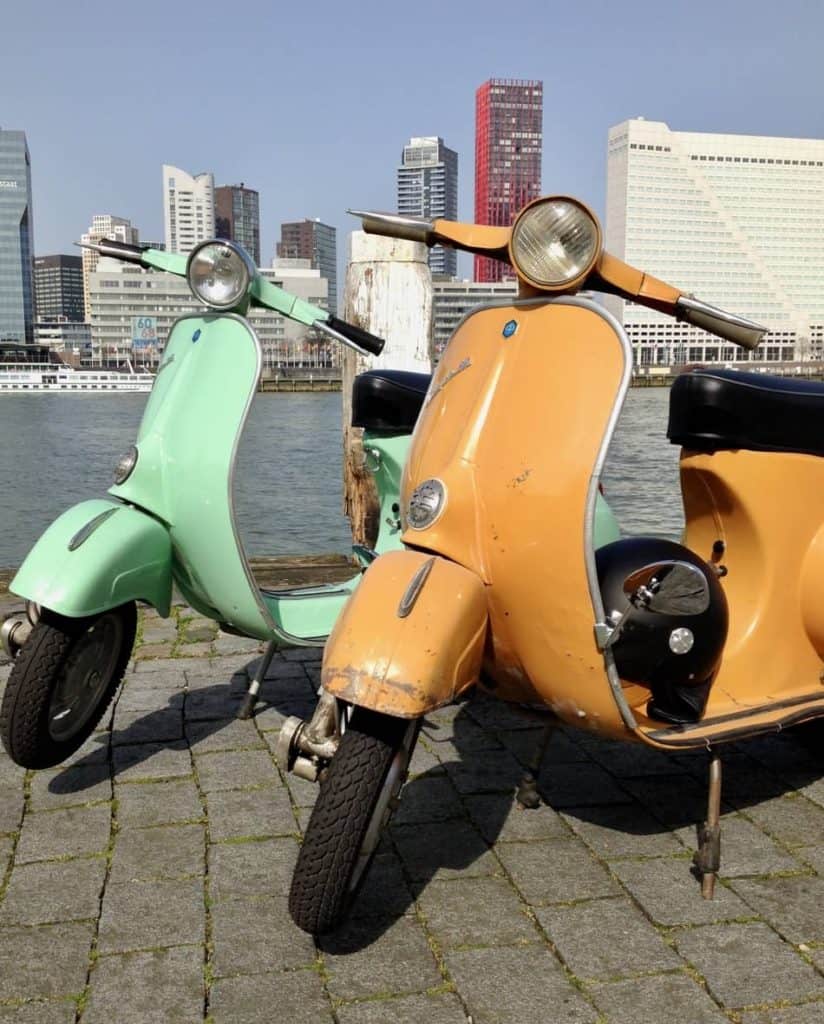
One of the most talked-about differences between the 2-stroke and the 4-strokes is its emissions. In this case, the 2-stroke is the bad guy of the two.
A 4-stroke engine burns pure gas, while a 2-stroke engine burns a mixture of gas and oil. This mixture emits far more hydrocarbons, carbon monoxide, and smoke than a 4-stroke engine. Not only are these emissions polluting and environmentally unfriendly, but the particulates that come out of the exhaust pipes are bad for human health as well. It causes smog, respiratory diseases, and even cancer.
A single 2-stroke engine produces pollution equivalent to that of 30 to 50 four-stroke automobiles
discoverymagazine.com
Unfortunately, since the 4-stroke gained popularity when it comes to being ‘cleaner’, the technological development of the 2-stroke has come to a halt. All focus is now on improving the 4-stroke. Electric engines are of course also gaining more momentum and are part of Piaggio’s future.
That said, there are still a lot of 2-stroke Vespas on the road and they are driven by many especially in Asia. It is good to have a look at what the differences are in emissions when it comes to the 2-stroke engine and a 4-stroke engine. Again, we are going to take the Vespa LX for a good comparison considering this is one of the few Vespas launched with a 2-and a 4-stroke engine.
| Vespa Model | CO2 emission |
| Vespa LX 50 4v (2012) | 62.4 CO2 g/km |
| Vespa LX 50 2T (2006) | 835.2 CO2 g/km |
Pretty shocking, right? A Vespa LX 50 2T produces 16 times more CO2 than a 4-stroke. Since a 2-stroke engine uses slightly more gas it is likely to emit more carbon dioxide. But I wouldn’t expect that much.
Unfortunately, CO2 is just one of the emissions of an engine. Others, which are more harmful such as NOx and hydrogen are often not taken into account when looking at the specifications of an engine. However, a Dutch independent research organization (TNO) has shown that a 2-stroke engine emits 25 times more pollutant particulates than a 4-stroke engine.
In an earlier post, we focused on how eco-friendly Vespas actually are. Here we go more in-depth on the emission of Vespa motor scooters.
2-stroke engines have more power
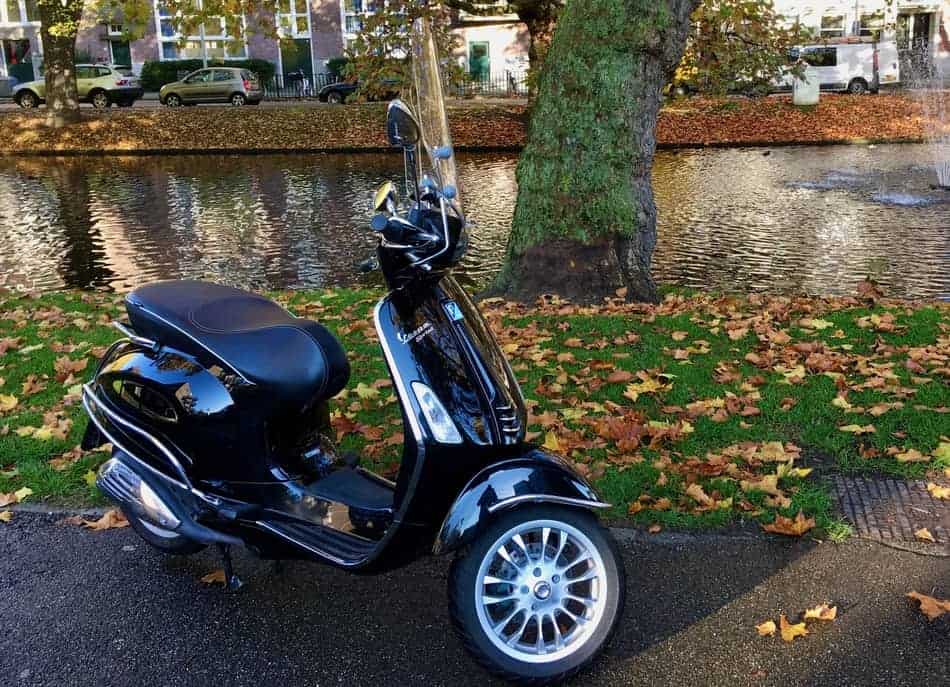
Two-stroke engines have a lot of power, especially when you compare them with the 4-stroke engine. A 2-stroke engine only needs 2-strokes to complete a full cycle, while a 4-stroke needs 4. This means if the 2-stroke engine would have 8000 RPM, it will be combusting fuel twice as much as a 4-stroke engine that also has 8000 RPM. (motorscooterguide.com)
In other words, a 2 -stroke engine creates 50% more power than a 4-stroke engine of the same engine size. Meaning a 2-stroke 50cc can produce the same amount of power as a 4-stroke 100cc.
So you can imagine why drivers love the 2-stroke engine. Especially in places where licenses for a 50cc are not necessary. A 2-stroke engine will run more powerful than a 4 stroke 50cc.
That said, the 4-stroke is still interesting in this case as the output of this engine is more steady and reliable. The engine will run smoother making driving more comfortable.
2-stroke engines use a oil-fuel mixture
Both the 2-stroke and the 4-stroke of a Vespa needs oil to lubricate the moving parts in the engine.
- 2-stroke: the 2-stroke oil is mixed directly with the gas. It usually needs a 2% oil/fuel ratio. The air-fuel mix flows through the engine and exits through the exhaust pipe.
- 4-stroke: the 4-stroke oil is poured into the crankcase from where it flows through the engine components. The oil doesn’t get burned, instead it flows back into the crankcase. The cycle then repeats itself.
The differences in oil use between a 2-stroke and a 4-stroke engine:
- 2-stroke oil doesn’t need to be changed, it only needs to be added every time you fill up for your Vespa. The 2- stroke oil burns together with the gas and evaporates in the air, causing a lot of pollution. When filling up a classic Vespa you need to add 2-stroke engine oil directly into the gas tank. The Vespa LX has a separate engine oil input, so you just need to regularly check if this isn’t too empty.
- 4-stroke oil continuously flows through the engine components. It will lubricate the components but it will also clean the engine before flowing back into the crankcase. It is therefore essential to change this oil and oil filter regularly (every 3000km/1850miles or every year).
While the use of 2-stroke oil doesn’t need to be replaced, it needs far less maintenance the 4-stroke oil. It is however more expensive as you always need to top it up when you get gas. The downside of the 4-stroke is to be changed properly, without spillage, and recycled. You need to go to a workshop to get the oil changed or you can do it yourself to avoid extra costs.
The 4-stroke engine is more complicated
2-stroke engines have a more simple design, few parts, and therefore easier to maintain. The 4-stroke has, on the other hand, more moving part such as the intake and exhaust valves, oil filters, shims, etc which are all subject to wear. Regular maintenance is therefore essential for the performance of this type of engine.
Additionally, the valves of the 4-stroke Vespa need adjusting and oil needs to be changed regularly to operate properly.
This makes the 4-stroke much more complex than the 2-stroke engine. Naturally, 4-stroke needs more maintenance leading to higher expenses than a 2-stroke engine.
Modern Vespas have a 4-stroke engine, classic does not

For Vespa, you can generally say that all classic Vespas have a 2-stroke engine and all modern Vespas have a 4- stroke engine. There are however some exceptions.
Vespas with 2-stroke and 4-stroke engine are:
| Vespa models | 2 stroke engine | 4 stroke engine |
| built till 1997 | ✔️ | |
| ET 50 (1996-2005) | ✔️ | ✔️ |
| ET 125 (1996-2005) | ✔️ | |
| ET 125/150 (1999-2005) | ✔️ | |
| PX Catalyzed 125/150 (1999-2016) | ✔️ | |
| GT 125/200 (2003) | ✔️ | |
| LX 50 (2006 -2014) | ✔️ | ✔️ |
| LXV 50 (2006) | ✔️ | |
| LXV 125(2006) | ✔️ | |
| GTV 125/150 (2006) | ✔️ | |
| LX 125/150 (2006-2014) | ✔️ | |
| S 50 (2008 -2014) | ✔️ | |
| S 125 (2008 – 2014) | ✔️ | |
| GTS 125/300 (2008) | ✔️ | |
| 946 (2012-) | ✔️ | |
| Primavera (2014-) | ✔️ | |
| Sprint (2014-) | ✔️ |
The last 2 stroke Vespa launched by Piaggio is the PX in 2017. The 2 stroke engine didn’t meet the Euro emission standards anymore. Today some cities in Europe have even prohibited 2-stroke engines from entering their cities.
For classic lovers this is of course a shame. The 2-stroke classic Vespas are timeless, a joy to look at and to own.
The driving experience is often one of the key factors between choosing a 2-stroke and a 4-stroke engine. If you are aiming for a classic Vespa then there is no way around it, it will be a 2-stroke engine. Modern Vespas are all 4-stroke engines, except for the LX and S models.
The 2-stroke engine makes more noise
It is difficult to say if noise is a good or a bad thing. I always smile when I hear a classic 2-stroke Vespa driving through the streets. It isn’t the sound of music, but it is the sound of something beautiful that’s approaching.
However, I can imagine that others find the sound loud and annoying and therefore prefer a 4-stroke, which is generally quieter.
The main reason why the 4-stroke Vespa makes less noise is due to the combustion. A 4-stroke engine has intake and exhaust valves to regulate the air/gas flow in and out of the combustion chamber. The combustion happens every other time the piston reaches the top of the cylinder. During that time the valve is closed muffling the sound of the power stroke.
Valves are absent for a 2 stroke engine. So at every stroke combustion occurs, resulting in twice more ‘bangs’ and twice more noise.
2-stroke engines usually have manual gears
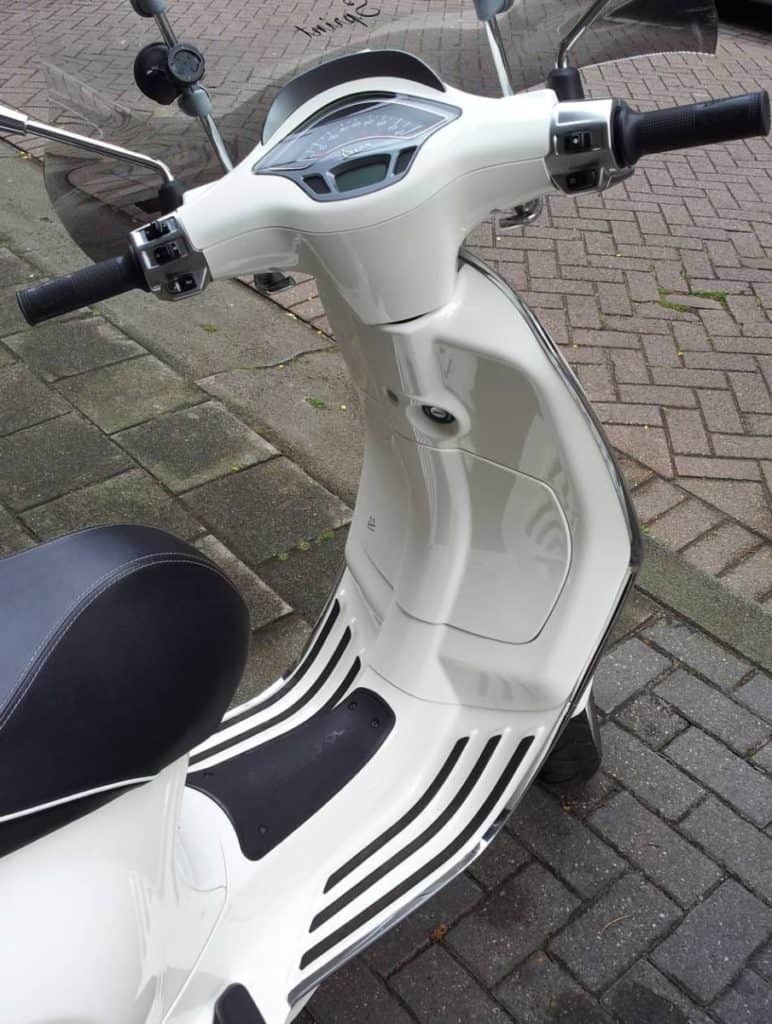
All 2-stroke Vespas, except the LX and S, have gears. Some drivers love driving gears while others prefer automatic. Those who prefer gears often do so because they feel they have more control over the bike plus it is less boring.
Driving the wrong gear will increase fuel consumption and make more noise. So you do need to practice a couple of times if you have never driven a manual-operated vehicle.
A Vespa with a 2-stroke engine has more bottom-end torque than a 4 stroke. This means that it has more power. This is especially noticeable when using the first gear when taking off at a traffic light. A 2-stroke Vespa can gain speed faster than a 4-stroke Vespa. Another example is when going uphill. A 2 stroke Vespa will be able to maintain its speed compared to a Vespa with a 4 stroke engine.
So as you can tell, a 2-stroke Vespa has its advantages. Nevertheless, the automatic 4 stroke is a comfortable ride when taking the Vespa through the city where you often need to stop and take a turn.
A 2-stroke engine is lighter than a 4-stroke
The 2-stroke engine is lighter than a 4-stroke engine. It is difficult to compare the weight of these types of engines on a Vespa since the chassis of modern 4-stroke Vespas are generally bigger. However, if an engine weighs more, the bike will be heavier. A heavy bike makes it more difficult to ride for inexperienced drivers.
There are stricter rules for 2-stroke engines
The 2-stroke engines emit high levels of greenhouse gasses which is toxic for the environment and for human health. In some cities in Europe, such as Amsterdam and Paris these types of engines are not permitted anymore.
For this reason alone, Piaggio does not make any Vespa models anymore with a 2-stroke engine. The last 2-stroke engine made is the PX 150cc, which didn’t even make it to the USA.
The 4-stroke is the future engine and is being further developed into a more efficient and environmental engine. The newest Primavera and Sprint come with an iGet engine. These first liquid-cooled Vespa models are in compliance with the Euro 4 Multi-Directive.
Summary of the good and the bad of a 2- and 4-stroke engines
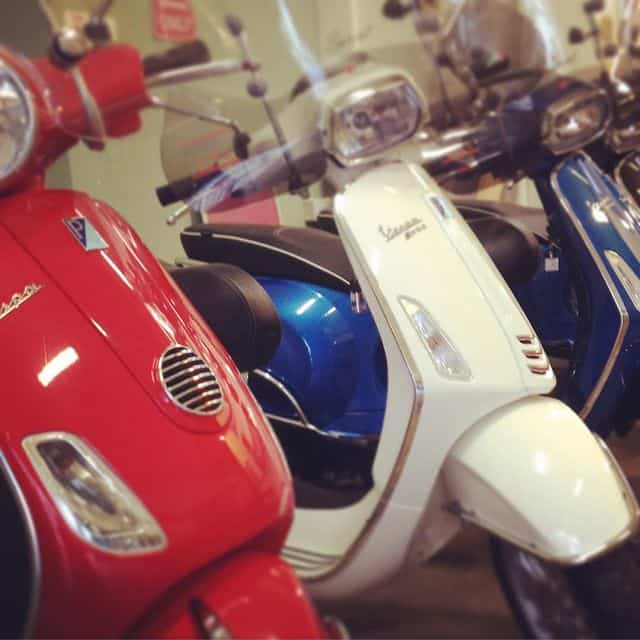

There are endless discussions on why you should go for a 2- or 4-stroke motorcycle. Some just prefer one over the other. However, when it comes to the Vespa, it isn’t much the choice of type of engine alone.
The model is one of the most important factors in choosing the type of Vespa. Vespas can be categorized into 2- stroke classic Vespas or 4-stroke modern Vespas. If you want to go for the modern Vespa then there is no other choice than to drive a 4-stroke, despite its good and bad points.
The same counts for the classic Vespa. If you have fallen in love with a specific classic model then again there is no way around it, you will be driving a low-maintenance polluting 2-stroke (unless you convert it to an electric which people are doing nowadays, however, that’s a topic for another time). Unfortunately, 2 stroke has its limitations. It is not welcome everywhere anymore due to its high emissions. Additionally, it has gears that are not favored by many.

